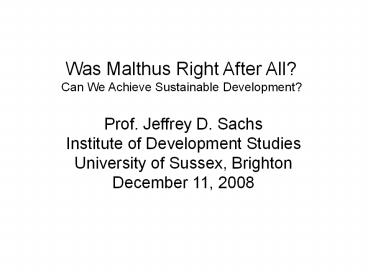Was Malthus Right After All? - PowerPoint PPT Presentation
1 / 47
Title:
Was Malthus Right After All?
Description:
Was Malthus Right After All? Can We Achieve Sustainable Development? Prof. Jeffrey D. Sachs Institute of Development Studies University of Sussex, Brighton – PowerPoint PPT presentation
Number of Views:145
Avg rating:3.0/5.0
Title: Was Malthus Right After All?
1
Was Malthus Right After All? Can We Achieve
Sustainable Development? Prof. Jeffrey D.
Sachs Institute of Development Studies University
of Sussex, Brighton December 11, 2008
2
- FOUR DEEP DRIVERS OF GLOBALIZATION TODAY
- Ecosystem Pressures in the Anthropocene
- Climate change water stress food supply
species extinction - Demographic Change
- Continued rapid population growth
Rebalancing global populations (e.g. Africa,
Islam) changing internal population balances
urbanization aging migration - Global Catch-Up Growth
- The Economics of pent-up growth. The Asian
Growth Catch Up. Prospects for Global Growth - Fragile States
- Globalization as a cause of failed states?
(e.g. Brain Drain) - Globalization as an amplifier of the costs
of failed states
3
The Two Senses of the Malthusian Threat Regions
Trapped in Extreme Poverty and Hunger, Notably
Sub-Saharan Africa Global Society Facing
Ecological Limits and the Possibility of Massive
Overshooting and Reversals
4
(No Transcript)
5
70,000
Billions, USD PPP
6
ECOSYSTEM STRESS The Epoch of the Anthropocene
7
Fig. 2. Human dominance or alteration of several
major components of the Earth system, expressed
as (from left to right) percentage of the land
surface transformed (5) percentage of the
current atmospheric CO2 concentration that
results from human action (17) percentage of
accessible surface fresh water used (20)
percentage of terrestrial N fixation that is
human-caused (28) percentage of plant species in
Canada that humanity has introduced from
elsewhere (48) percentage of bird species on
Earth that have become extinct in the past two
millennia, almost all of them as a consequence of
human activity (42) and percentage of major
marine fisheries that are fully exploited,
overexploited, or depleted (14).
8
The Three Great Drivers of Anthropogenic
Change Food Energy Industrial Pollutants
(including those linked to food and energy)
9
(No Transcript)
10
Dead Zone In Gulf of Mexico
Thresholds of Hypoxia in Marine Ecosystems, PNAS,
2008 Vaquer-Sunyer and Duarte
11
(No Transcript)
12
Stern Review
13
(No Transcript)
14
Kg Per Person, Annual
15
(No Transcript)
16
World Bank World Development Indicators
17
Demography The Continuing Population Threat
18
(No Transcript)
19
(No Transcript)
20
(No Transcript)
21
Western Islam North Africa, the Middle East,
and Turkey
22
(No Transcript)
23
(No Transcript)
24
The Age of Convergence Economics of Catch-Up
Growth
25
Forces of Divergence (1750 1950) Concentration
of Technological Capacity
Resource Endowments Political
Conquest Forces of Convergence (1950 -
2050) Diffusion of Technological Capacity
Sovereignty Globalization
26
(No Transcript)
27
(No Transcript)
28
(No Transcript)
29
Projections of GNP in US, China, and India
30
FRAGILE STATES IN AN INTERCONNECTED WORLD
31
Ending Poverty Through Targeted
Investments Agriculture Health Education Infrast
ructure roads, rail, power, water and
sanitation, connectivity Business
Institutions Community Institutions The
Millennium Development Goals The Millennium
Villages and Millennium Cities
32
(No Transcript)
33
(No Transcript)
34
The Sahel
35
(No Transcript)
36
El-Fasher Weather Station
37
Pathways to Sustainable Development Global
Goals Millennium Development Goals
(MDGs) Health for All (AIDS, TB, Malaria,
others) Biological Diversity (UNCBD) Climate
Change (UNFCCC) Desertification
(UNCCD) Directed Technological Change Food,
Energy, Pollutants Population Stabilization Sust
ainable Urbanization Financing Global Public
Goods (Who will pay and how?) Global Ethics
Human Rights and the Human Future
38
The Need For Technological Advances The
Inadequacy of current technologies Energy
systems Food systems Industrial
ecology (pollutants, wastes, resource
uses) Incentives for RDDD For the poor For
the commons For resource scarcity Creating an
Innovation System for Sustainable
Technologies Patents, public financing,
philanthropy, open-source, technology transfer
mechanisms
39
The Role of Global Institutions Which
Institutions? Supranational treaties (CBD,
UNFCCC, UNCLOS) Global organizations (UN,
Bretton Woods Institutions, WTO) Regional
Governments (EU, AU, NAFTA) Global
Financing? ODA, New Financing Mechanisms such
as UNITAID, IFFm, Advanced Market Commitments,
Carbon Levies, Tobin Tax
40
The Role of Social Knowledge, Culture, and
Values Sustainable lifestyles urban life
attitudes to equality and inequality (gender,
class, race, nation, geography) attitudes
towards fertility attitudes towards migration
and cultural diversity attitudes towards the
future
41
Can We Afford Sustainable Development? Climate
Change Mitigation ( 1 percent of GNP) Climate
Change Adaptation (lt 0.2 percent of GNP) Global
Poverty Reduction (0.7 percent of GNP) Family
Planning and Reproductive Health Services (lt
0.1 percent of GNP) De-Nuclearization (savings
of gt 0.1 percent of GNP) Peace in todays
conflict zones (large savings)
42
(No Transcript)
43
(No Transcript)
44
Towards a Global Ethic
45
The Future is Under-Determined Possibilities
of Historical Disjuncture (1914, 1917, 1933,
1945) Scientific and Technological Potential is
At All-Time High Leadership is the alignment
of expectations Democratization,
Decentralization, and Governability
46
Is Global Cooperation Feasible? Clash of
Civilizations? Resource Wars and Interstate
Competition? International Commitments,
Enforceability, and Free Riders The diverse
roles of international organizations, states,
business, civil society, and individuals
47
So let us not be blind to our differences, but
let us also direct attention to our common
interests and the means by which those
differences can be resolved. And if we cannot
end now our differences, at least we can help
make the world safe for diversity. For in the
final analysis, our most basic common link is
that we all inhabit this small planet. We all
breathe the same air. We all cherish our
children's futures. And we are all mortal.
John F. Kennedy American
University June 10, 1963































